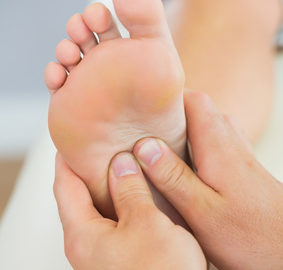When people think of foot pain especially foot pain that is located on the bottom of the foot, the mind often goes right to plantar fasciitis. While some pain located on the plantar surface, or bottom, of the foot is plantar fasciitis, there are many other things that can be the culprit.
It is important to properly diagnose foot pain, in order to best direct treatment!
So, what is Morton’s Neuroma?
Morton’s neuroma is a condition where part of the nerve (neuroma), running under the ball of the foot becomes irritated. It is possibly affected by local swelling or compression / squeezing of the nerve. The tissue in the ball of the foot may become thickened and compress the nerve as well It is common to have Morton’s neuroma between the third and fourth metatarsal bones. The result is local pain or numbness as well as pain and numbness in the little toes.
How did I develop Morton’s Neuroma?
Like main pain related conditions of the foot, Morton’s Neuroma can happen quickly (acute) or develop over time (chronic). Whether this neuroma happens suddenly or over time is dependent on many things:
Sudden Onset
A sudden onset of Morton’s Neuroma may be from adding a new activity. For example, the weather is getting nicer, maybe you have been walking in one type of shoe and then you switch to a lighter running shoe. This sudden change shouldn’t be that big of a deal BUT you have been walking 5km daily in one type of footwear and then you change to a thin souled shoe that you haven’t worn before and you walk 5km. Your foot and the tissues are used to walking the 5km with more cushioning and have adapted to this. The foot may have reached its normal “max impact” at 2km in the new shoes. Now you have swelling and inflammation around the nerve…
You see where this goes…
Some causes of Morton’s Neuroma can be confusing. The pain seems to happen all of a sudden. You cannot recall adding anything new to your routine. You haven’t walked further, ran further, jumped more, etc. But the pain is in the ball of your foot and toes all of a sudden.
This may be an issue that has built up over time…
Onset Over Time
This may be the result of a combination of things. The Chiropodist or Physiotherapist will (as in acute cases) do some detective work.
They will ask you about:
- Your activities / sports
- Your life and any changes (this includes sleep and stress levels)
- Your footwear
- When it bothers you / any patterns
- Changes in health
- Any other painful areas
- etc.
Many people don’t always see the connection of why a physio would ask such “personal” questions, but pain or injury as well as the recovery don’t happen in a vacuum. These types of questions help the Physio, RMT, Chiropodist and Yoga Therapist develop a treatment plan with you as well.
The Chiropodist / Physiotherapist may:
- Observe how you walk, run, jump, land, pivot (depending on your activities)…
- Observe how you stand in bare feet
- Observe the wear pattern on your shoes (and see what shoes you wear regularly)
- Palpate (touch) around the area
- Test muscle strength and range of motion
- etc.
The Chiropodist will take all of this information and communicate a formal diagnosis to you. This formal diagnosis is a small piece of the puzzle believe it or not. It is all of the other information that they gleaned from their assessment with you that is the important stuff. If we do not find the WHY then the treatment plan will be lacking.
Stay tuned for another blog with treatment possibilities of Morton’s Neuroma. This is the type of painful foot condition where a team of Chiropodists / Foot Specialists and Physios and RMTs will be helpful to work to treat Morton’s Neuroma.
If you have foot pain that is affecting your activity and daily life, we are here to support you.
Contact us at our North Oakville Physio and foot clinic. Patients from Oakville, Burlington, Milton and Mississauga trust us with their families care!



